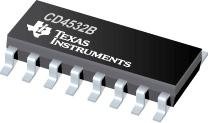CD4532B consists of combinational logic that encodes the highest priority input (D7-D0) to a 3-bit binary code. The eight inputs, D7 through D0, each have an assigned priority; D7 is the highest priority and D0 is the lowest. The priority encoder is inhibited when the chip-enable input EI is low. When EI is high, the binary representation of the highest-priority input appears on output lines Q2-Q0, and the group select line GS is high to indicate that priority inputs are present. The enable-out (EO) is high when no priority inputs are present. If any one input is high, EO is low and all cascaded lower-order stages are disabled.
●The CD4532B types are supplied in 16-lead hermetic dual-in-line ceramic packages (F3A suffix), 16-lead dual-in-line plastic packages (E suffix), 16-lead small-outline packages (M, M96, MT, and NSR suffixes), and 16-lead thin shrink small-outline packages (PW and PWR suffixes).
● Converts from 1 of 8 to binary
● Provides cascading feature to handle any number of inputs
● Group select indicates one or more priority inputs
● Standardized, symmetrical output characteristics
● 100% tested for quiescent current at 20 V
● Maximum input current of 1 µA at 18 V over full package temperature range; 100 nA at 18 V and 25°C
● Noise margin (full package-temperature range):
● 0.5 V at VDD = 5 V
● 1.5 V at VDD = 10 V
● 1.5 V at VDD = 15 V
● 5-V, 10-V, and 15-V parametric ratings
● Meets all requirements of JEDEC Tentative Standard No. 13B, "Standard Specifications for Description of "B" Series CMOS Devices"
● Applications:
● Priority encoder
● Binary or BCD encoder (keyboard encoding)
● Floating point arithmetic
●Data sheet acquired from Harris Semiconductor


